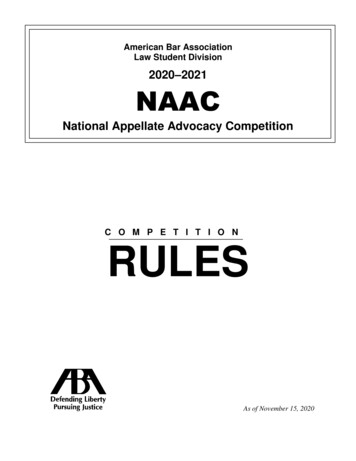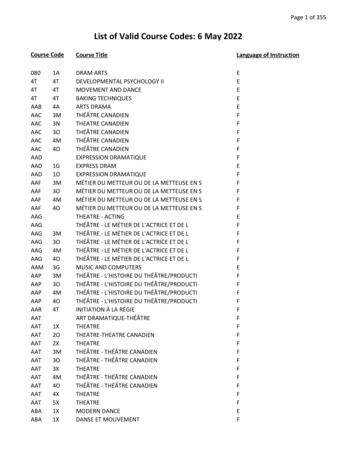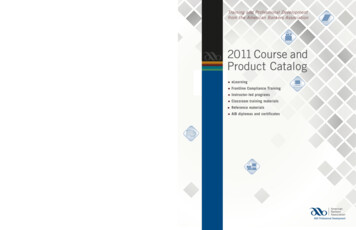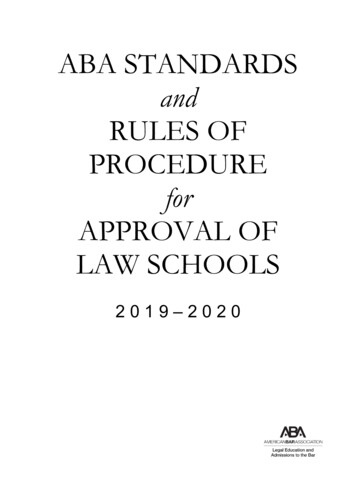
Transcription
American Bar AssociationLaw Student Division2020–2021NAACNational Appellate Advocacy CompetitionC O M P E T I T I O NRULESAs of November 15, 2020
American Bar AssociationLaw Student DivisionNational Appellate Advocacy Competition RulesTable of 18.19.20.21.22.23.24.25.26.27.Preamble .1Introduction .1Administration .1Eligibility .2Teams .3Team Pairings, Designations, and Anonymity .3Competition Problem and Copyright .4Competition Format .5Competition Schedule .6Competition Procedures for Oral Arguments and Briefs .6Scoring and Judging Standards.11Judges’ Feedback .13Announcement of Results .13Bailiffs .13Competition Judges .15Protests .15Penalties .16Competition Materials, Updates, and Clarifications .17Regional Competitions .18National Finals .18Faculty Coaches or Advisors .18Assistance .19Prohibited Communication and Attendance .19Consent .20Awards .21Professional Conduct .22Rules Interpretation .23Cancellation .23AppendicesA.B.C.D.E.F.G.Competition Schedule Samples—Regionals and National Finals.24Certification Letter Format .26Official Brief Ballot .27Sample Team Brief Results .29Oral Argument Ballot .30Examples of the Tally Sheets .31Bailiff Instructions and Bailiffs’ Worksheet .33This work by American Bar Association is licensed under a Creative Commons Attribution-NonCommercial 4.0 International License.
American Bar AssociationLaw Student DivisionNational Appellate Advocacy Competition RulesPreambleThese Competition Rules are supplemented by documents posted to the NAACCompetitors Page. Each team is responsible for reviewing these Rules and thesupplemental documents, such as the Rules Supplement and the Tips for SubmittingBriefs 2020.Article 1—IntroductionThe ABA Law Student Division created the National Appellate Advocacy Competition(or NAAC) in 1978 to emphasize the development of oral advocacy skills through arealistic appellate advocacy experience. Competitors participate in a hypotheticalappeal to the United States Supreme Court. The competitors must write a brief aseither Petitioner or Respondent and then argue the case in front of the mock court. Thelawyers and judges who serve as judges are required to read a bench memo and theProblem in preparation for the oral arguments.Article 2—Administration1.The ABA Law Student Division and the NAAC Subcommittee conduct the NAAC.The NAAC Subcommittee directly administers the competition at both theregional and national levels. The Law Student Division’s Chair appoints membersof the NAAC Subcommittee. Our webpage can be found ot-court/.2.Courthouses. To provide a realistic appellate experience, the ABA Law StudentDivision holds the regional and National Finals in state and federal courthouses.As a condition of using the courthouses, the Division agrees not to disturb theplacement of furniture, equipment, and electronics. Therefore, only thecompetition administrators will move furniture or turn off or unplug electrical/electronic equipment including microphones and video monitors.3.Furniture and Equipment. By competing, team members affirm that they will notmove any furniture, including the podium, or disturb any equipment, including,but not limited to, monitors, microphones, and electrical/electronic cords, in anycourtrooms used for the competition, even if a judge asks the competitor to moveit. Violation of this Article shall result in the imposition of a significant penalty, upto and including disqualification.4.Participants and Observers. Many courthouses require the ABA Law StudentDivision to provide a list of people associated with the competition. The Division1
obtains the competitors’ names from the Team Member Reporting Form. Teamsmust report the names of their NAAC coach(es) or advisors, bailiff(s), and anyguests, using an online form developed for this purpose. The online Participantand Observers Form will be posted to the NAAC Home Page in January.Article 3—Eligibility1.Only law students who are candidates for a Juris Doctor degree and are enrolledduring the semester or quarter of the regional competition are eligible toparticipate.2.Visiting students may represent either their home school or the school they arevisiting, but not both, during any academic year.3.Students who graduate or visiting students who return to their degree-grantinginstitution between the regional competition and National Finals cannot besubstituted at the National Finals. These students are encouraged to confirmeligibility and reimbursement with their law schools.4.Unless otherwise provided for in a given year, all ABA-approved law schools areeligible to enter up to two team(s) in the competition. Additional teams may beapproved, if space allows. The entry fees are posted to the Law Student Divisioncompetition website5.To enter the competition, the dean of the participants’ law school must approvethe entry form, and a full- or part-time faculty member or a lawyer approved bythe law school must agree to serve as the NAAC coach or advisor. The LawStudent Division Chicago Office must receive the entry form and fee by thedeadline posted on the competition’s website.6.Participation in the Law Student Division competitions is limited toAmerican Bar Association premium members. Thus, law students registeredto compete in this competition, including alternate team members, must bepremium members of the ABA Law Student Division. The annual fee to be apremium member of the ABA Law Student Division is 25.00. To join, please callthe ABA Service Center at (800) 285–2221 or visit the ABA website athttps://abaforlawstudents.com/gopremium/. Acceptance of entry forms and feesreceived later than the deadline is at the discretion of the Law Student Divisionand the NAAC Subcommittee.7.Names of team members and alternates and their ABA membership identificationnumbers are due to the Law Student Division Chicago Office by the team namesubmission deadline posted online. Failure to satisfy this requirement may makea competitor ineligible to compete. Late team name submissions may beaccepted at the discretion of the ABA.2
Article 4—Teams1.A team consists of two or three law students attending the same ABA-approvedlaw school. Only law students who have been registered as alternates will beeligible to become an approved substitute.2.After the name submission deadline, team members may not be substituted,except for good cause such as death, severe illness, or other uncontrollablecircumstance. The proposed substitute, however, must be registered as analternate on the name submission form. A team must obtain the NAACSubcommittee’s written approval to substitute a team member.3.Each team is responsible for bringing a bailiff, who does not need to be an ABAmember, unless the bailiff is a member of the team, to the regional and theNational Finals (see Article 14).Article 5—Team Pairings, Designations, and Anonymity1.The ABA Law Student Division will randomly assign a number designation toeach team. This number will be the sole method of identifying the team tocompetition judges, including brief graders, during the competition. Anyoneaffiliated with a team, including team members, NAAC coaches/advisors, bailiffs,and observers, may not directly or indirectly divulge their law school’s identity tothe judges. This includes information contained in the brief’s properties andmetadata. Violation of this rule shall result in a penalty, up to and includingdisqualification.2.The NAAC Subcommittee will set pairings based upon the following criteria:a.The NAAC Subcommittee will randomly assign sides without regard toseeding for the first two rounds at the regional and national levels. Teamswill argue once for the Petitioner and once for the Respondent during thefirst two rounds. The first round argument may be off-brief. In every otherround, the higher seeded team will select its side.b.Round 1: Teams will be power protected by brief score. A team will notface another team from its school.c.Round 2: Teams will be power protected by brief score. A team will notface the same team faced in Round 1. A team will not face another teamfrom its school.d.Round 3: Teams will be power matched within their win/loss category (i.e.,2–0 team with highest cumulative margins plays 2–0 team with lowestcumulative margins, etc.; 1–1 team with highest cumulative margins plays1–1 team with lowest cumulative margins, etc.; 0–2 team with highest3
cumulative margins plays 0–2 team with lowest cumulative margins, etc.).If an odd number of teams have the same win/loss record in any category,the lowest-seeded team in the higher category will become the highestseeded team in the next category down and argue against the lowestseeded team in that category. A team from a school with only two teamsregistered for a regional will not face another team from its school.3.Odd Number of Teams in a Regional: A bye round will be necessary if an oddnumber of teams compete in the regional competition. The NAAC Subcommitteewill select one team at random to argue twice in Round 1. The selected team willnot argue during Round 2; rather this team will argue once for petitioner andonce for respondent during Round 1. The arguments will be back-to-back. AfterRound 2, the highest seeded team will receive a bye in Round 3 and willautomatically be the top seed in Round 4.Article 6—Competition Problem and Copyright1.The NAAC Problem shall be released on the date listed online; but only to teamsfor which a school has identified by name each of the students who are membersof the teams. Otherwise, the Problem will be released to teams once the schoolhas identified by name each of the students who are members of a registeredteam, provided that such members are designated within 14 days after theProblem is released2.The NAAC Subcommittee shall entertain requests for clarifications for 15 daysafter release of the Problem. Each request for clarification must be submitted viathe form provided online. Any clarifications will be posted to the NAAC webpage(see Article 2(1)) after the deadline.3.The NAAC Subcommittee is responsible for developing the Problem.4.All ABA Law Student Division Competition problems (also known as case files,scenarios, fact patterns, and records) are copyright protected under UnitedStates copyright laws. Problems may only be used by the registered competitorsduring the year of the competition. Audio, visual, or written versions of theseproblems may NOT be posted and/or shared online or digitally distributed in anymanner without express written permission from the ABA Law Student Division.Failure to comply with this requirement may result in immediate disqualificationfrom the competition or may subject you to civil and/or criminal liability under 17U.S.C. § 100 et seq.5.The persons and events depicted in the Problem are purely fictional, and theProblem is prepared solely for the educational exercise being conducted in theCompetition. Any resemblance to actual persons, living or deceased, isunintentional and purely coincidental.4
Article 7 —Competition Format1.2.Regional Competitionsa.The regional competition consists of five rounds.b.Each team will argue at least three rounds.c.Sixteen teams advance to Round 4. Teams will be seeded and placed in abracket according to the following criteria: (1) win/loss record, (2) highestcumulative margin of victory, and (3) brief score. The highest seeded teamwill play the lowest seeded team, etc. However, the pairings will be alteredbefore Round 4 to prevent two teams from the same school from meetingin Round 4 or Round 5, except when more than two teams from the sameschool advance to Round 4.d.In the Subcommittee’s discretion, in regionals consisting of more thanthirty-six teams, twenty (rather than sixteen) teams may advance to Round4, with seedings and bracket placements to follow the format set forth inthis Section. Where practicable, and subject to factors such as judge andcourtroom availability and other administrative concerns, theSubcommittee will tend to exercise its discretion to see that there is atleast one regional champion for every eight to nine teams participating in aregional competition.e.The Round 4 winners will advance to Round 5.f.The Round 5 winners will advance to the National Finals.National Finalsa.The National Finals consist of six rounds.b.Each team will argue at least two rounds.c.Sixteen teams advance to the octofinal rounds. Teams will be seeded bythe following criteria: (1) win/loss record, (2) highest cumulative margin ofvictory, and (3) brief score. Pairings for the octofinal rounds will be powerprotected. The highest seeded team will play the lowest seeded team, etc.However, the pairings will be altered before the octofinal rounds to preventtwo teams from the same school from meeting prior to the National FinalsChampionship Round, except when more than two teams from the sameschool advance to the octofinal round. The octofinal winners will advanceto the quarterfinal round; the quarterfinal round winners will advance to thesemifinal round; the semifinal round winners will advance to the final5
round; and the final round winner will be declared the National Championteam.Article 8—Competition ScheduleSample Regional and National Finals schedules can be found in Appendix A to theseRules. There will be slight differences in the schedules due to the virtual format in 2021.Please consult the Rules Supplement for more information.Article 9—Competition Procedures for Oral Arguments and Briefs1.2.Oral Argumentsa.Two team members will argue in each round of oral argument. A teammay vary which members will argue from round to round. Only those twopeople arguing may sit at counsel table.b.Oral argument is limited to a total of 30 minutes per team.1)Although a team may divide its 30 minutes as it chooses, no teammay allocate more than 17 minutes to one advocate, includingrebuttal.2)The petitioner may reserve up to a maximum of 5 minutes forrebuttal. Only one advocate may argue rebuttal. The petitionerneed not identify which team member will rebut prior to the round.3)The judges may, in their sole discretion, extend any speaker’s time.Briefsa.A team may choose to write its brief on behalf of the petitioner orrespondent. If two teams from the same school enter the competition, oneteam will submit a petitioner’s brief and one team will submit arespondent’s brief.b.A brief must contain, under appropriate headings and in the followingorder:1)2)3)4)a statement of the issues presented for review;a table of contents with page references;a table of authorities, with sections for cases (alphabeticallyarranged), statutes, and other authorities, with references to thepages of the brief where they are cited;a statement of facts relevant to the issues presented for review withappropriate references to the record;6
5)6)7)8)a statement of the case briefly indicating the nature of the case, thecourse of proceedings, and the disposition below;a summary of the argument;the argument, which must contain: the party’s contentions and thereasons for them, with citations to the authorities and parts of therecord on which the parties relied; anda short conclusion stating the precise relief sought.c.All citations should conform to the most recent edition of A UniformSystem of Citation (commonly known as The Bluebook) or the most recentedition of ALWD Guide.d.Font shall be 12-point, Times New Roman. Typed matter must be doublespaced, except footnotes, argument headings, and extended quotationsmay be single-spaced. Footnotes, argument headings, and single-spacedquotations must appear in the same size font as the rest of the text.e.The margins shall be one inch on all four sides.f.A brief shall not exceed 14,000 words. The word count starts at thebeginning of the jurisdictional statement and runs to and includes theconclusion. The word limit does not include the cover page, table ofcontents, or table of authorities. The team may rely on the word count ofthe word processing system used to prepare the brief. If the word count onthe e-brief submission is different from the word count on the certificationletter, the higher word count controls.g.The electronic brief must be a PDF-file and be formatted to fit an 8 ½" x11" paper size, no appendices.h.Brief Covers1)The cover must include, in the lower right corner,a)b)c)2)i.the team's numeric designation,the regional city in which the team will compete, andwhether the brief is written on behalf of the Petitioner orRespondent.No information serving to identify the team or its law school, otherthan its numeric designation supplied by the Chicago office, may beincluded on the cover, anywhere inside the brief, or in the brief’sproperties or metadata.Electronic briefs will be posted on the ABA website to allow allparticipating teams access. The briefs will be posted about 10 days after7
the deadline for submission and will be accessible from the NAACwebpage.3.4.Certification Lettera.Each team submitting a brief shall certify, with their signatures, that thebrief was prepared and served in accordance with the NAAC Rules.b.All teams are required to use the certification letter found in Appendix B.c.The certification shall be submitted as a PDF-file separate from the brief.d.Coaches must complete the Coach Certification provided by the ABA.Service of Briefs and Certification Lettersa.Each team must serve one electronic copy of its brief upon the ABA LawStudent Division. Multiple submissions are not allowed. When multiplesubmissions are received, the ABA Law Student Division will producecopies of the first brief received from each team. This will be the brief sentto the competition brief graders.b.Teams shall submit the certification letter in conjunction with the electronicbrief served on the ABA Law Student Division. One PDF-file containingmultiple electronic copies of the certification letter may be submitted inconjunction with the team’s electronic brief if necessary to capture eachteam member’s signature. Electronic signatures are allowed, as directedby the ABA.c.Failure to submit the properly signed certification in conjunction with theelectronic brief will result in a penalty.d.Filing a false certification is grounds for disqualification.e.Deadlines for Service1)Both the electronic brief and the certification letter must arrive at theABA by the deadline posted online.2)Failure to submit the brief and certification letter by the deadline forservice will result in a penalty, up to and including disqualification.See Article 16.3)No briefs or certification letters will be accepted later than 48 hoursafter the scheduled deadline.8
6.Method of Deliverya.Brief1)The electronic brief must be uploaded as a PDF-file via the NAACElectronic Brief and Certification Submission Form posted online.The NAAC Electronic Brief and Certification Submission Form webpage can be accessed from the NAAC home page, as identified inthe submission instructions email.2)The brief file name must start with the word “team” followed by theteam number. All letters must be lower case, and there should beno space between the word “team” and the team number (e.g.,team401)a)The size of the uploaded brief file can be no larger than 2MB.b)The following fields must be completed on the NAACElectronic Brief and Certification Submission Form:i.ii.iii.iv.v.vi.vii.3)the team’s numeric designation;the law school’s name;the team members’ names;whether the team wrote on behalf of the Petitioner orRespondent;the regional city in which the team will compete;the word count; andthe submitter’s name, telephone number, emailaddress, and local time.c)The uploaded brief file must contain only an electronic copyof the submitted brief. The brief must be a single document,as a PDF-file. The document must not contain anyappendices, any portion of the appellate record (other than aportion contained in the brief’s text), hypertext links to othermaterial, or any document other than the brief itself.d)The uploaded brief file must be free of viruses or any otherfiles that would be disruptive to the Law Student Division’scomputer system.Certification Lettera)The electronic copy(ies) of the certification letter must beuploaded as one PDF-file via the NAAC Electronic Brief and9
Certification Submission Form, which can be accessed viathe NAAC home page. Certification letters faxed to the ABALaw Student Division will not be accepted.b)The certification file name must start with the word “team”followed by the team number and then followed by the word“certification.” All letters must be lower case, and thereshould be no space between the word “team,” the teamnumber, and the word “certification” (e.g.,team401certification).c)The size of the uploaded certification file can be no largerthan 2 MB.d)The uploaded certification file must contain only anelectronic copy of the submitted certification letter(s). Thecertification must be submitted as a single PDF-file and mustnot be contained in the brief.e)The uploaded certification file must be free of viruses or anyother files that would be disruptive to the Law StudentDivision’s computer system.4)Teams are required to submit one brief file and one certification fileon the same online Brief and Certification Submission Form.5)If you experience difficulty with the Brief and CertificationSubmission Form and are unable to submit your team’s brief usingthe form, please try again. If you remain unsuccessful on yoursecond attempt, please submit your brief via email tocompetitions@americanbar.org, with the brief as an attachment, aswell as the Certification Letter. Your email message should containthe following information:a)b)c)d)e)f)g)h)i)team’s numeric designation;the law school’s name;the team members’ names and ABA member identificationnumbers;whether the team wrote on behalf of the Petitioner orRespondent;the regional city in which the team will compete;the word count;the submitter’s name, telephone number; and email address;the local time; anda note explaining the error message you received oneach submission attempt.10
Only briefs submitted by way of the Brief Submission Form will beconsidered for grading, unless the NAAC Subcommitteedetermines the inability of a team to electronically file the brief wasa result of a defect with the ABA filing system.Article 10 —Scoring and Judging StandardsTeams are evaluated and scored based on the quality of their presentations and not onthe merits of the side they represent.1.Brief Scoring. Each brief grader will evaluate the briefs based upon a 100-pointscale. Knowledge of the law and persuasiveness will be the primary standards ingrading, but form, style, and appearance will also be considered. Grading will beanonymous, with each brief identified only by its team number. The Official BriefBallot can be found in Appendix C to these Rules.Brief graders are required to grade to a 75-point median.2.3.Reduced Brief Scorea.At the regional level, the reduced brief score will be determined bydropping the highest and lowest scores, averaging the remaining threescores (i.e., the average score), and dividing that average by three. Anybrief penalties will be deducted from the average score. See Appendix Dfor a sample brief results document.b.At the national level, the reduced brief score will be determined bydropping the highest and lowest scores, averaging the remaining threescores, and dividing that average by three. Any brief penalties will bededucted from the average score.Oral Argument Scoringa.Generally1.Each judge will evaluate each advocate upon a 100-point scale,considering substantive content of argument, knowledge of therecord, extemporaneous ability, courtroom demeanor andprofessionalism. A sample Oral Argument Ballot can be found inAppendix E to these Rules.2.If a judge a judge scores below the range in any given criteria orfails to provide a score for any given criteria, and the bailiffs returnto the scoring room without correcting the error, the advocate willreceive only the number of points given by the judge, or in the case11
3.b.of no score, a zero, for that particular criterion.If a judge the score was above the range in any given criteria, andthe bailiffs return to the scoring room without correcting the error,the advocate will receive half the number of points given by thejudge for that particular criterion.4.If the sum of the scores assigned for each criterion differs from thetotal score assigned by a judge, the scores for each criteria control.5.A team’s margin of victory is calculated by subtracting the losingteam’s point total from the winning team’s point total.6.If a team forfeits an assigned round, the team’s scheduledopponent (the opponent) will be the winner of that round and theirmargin of victory will be one point, unless the opponent’s reducedbrief score is more than one point higher than the forfeiting team’sreduced brief score, in which case the margin of victory for theopponent shall be the difference between the reduced brief scores.Round Outcome1.In rounds 1, 2, and 3 of a regional competition, and in rounds 1 and2 of the National Finals, each team’s round score will be computedby weighing the oral argument two-thirds (66.67%) and the briefscore one-third (33.33%). In these rounds, the winner will be teamwith the higher round score. If a tie exists after the oral argumentand brief scores are considered, the team winning the oralargument portion will be declared the winner of the round. In thissituation, the margin of victory for the winning team will be zero,and the margin of loss for the losing team will be zero.2.In rounds 4 and 5 of a regional competition, the winner will be theteam that receives the higher argument score on a majority of theuntied ballots submitted by the oral argument judges. If neitherteam receives a majority of ballots, the winner will be the team withthe highest total argument score if a tie exists after ballots and oralargument scores are considered, the team with the highest briefscore shall be declared the winner.3.In the octofinals, quarterfinals, and semifinal rounds of the NationalFinals,
3. Each team is responsible for bringing a bailiff, who does not need to be an ABA member, unless the bailiff is a member of the team, to the regional and the National Finals (see Article 14). Article 5 — Team Pairings, Designations, and Anonymity . 1. The ABA Law Student Division will randomly assign a number designation to each team.










